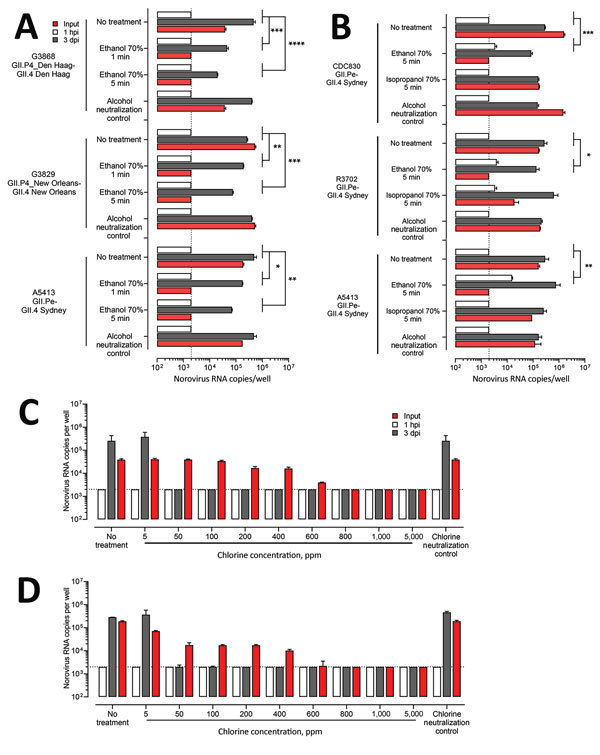Figure 8.

Inactivation of human norovirus with 70% alcohol or chlorine solution in suspension. A) Ten percent fecal filtrates (G3868 [GII.4 Den Haag], 2.04 × 106 RNA copies; G3829 [GII.4 New Orleans], 4.14 × 106 RNA copies; A5413 [GII.4 Sydney], 1.58 × 107 RNA copies) were either treated or not treated with 70% ethanol for 1 min or 5 min at room temperature. We added complete media without growth factors supplemented with 10% fetal bovine serum to neutralize remaining ethanol. B) Ten percent fecal filtrates from 3 GII.4 Sydney strains (CDC830, 2.89 × 107 RNA copies; R3702, 7.73 × 107 RNA copies; A5413, 1.58 × 107 RNA copies) were either treated or not treated with 70% ethanol or 70% isopropanol for 5 min at room temperature and neutralized with complete media without growth factors supplemented with 10% fetal bovine serum. C, D) Ten percent fecal filtrates (G3868, 2.04 × 106 RNA copies [C]; A5413, 1.58 × 107 RNA copies [D]) were either treated or not treated with freshly prepared chlorine solutions of increasing concentrations (5, 50, 100, 200, 400, 600, 800, 1,000, and 5,000 ppm) for 1 min at room temperature. Sodium thiosulfate (final concentration 50 mg/L) was added to neutralize the remaining free chlorine. For all experiments, HIEs were then infected with 100 μL of treated or not treated fecal filtrate. After 1 h at 37°C in 5% CO2, we washed the monolayers, added differentiation media, and incubated for 3 d. Data represent mean ± SD of 2 experiments with 3 wells for each treatment and time point. For each fecal filtrate, we performed 1-way analysis of variance followed by Dunnett’s test. Dotted lines represent RT-qPCR limit of detection. p values are compared with the nontreated fecal filtrate: *p<0.05; **p<0.01; ***p<0.001; ****p<0.0001. dpi, days postinfection; hpi, hours postinfection.
